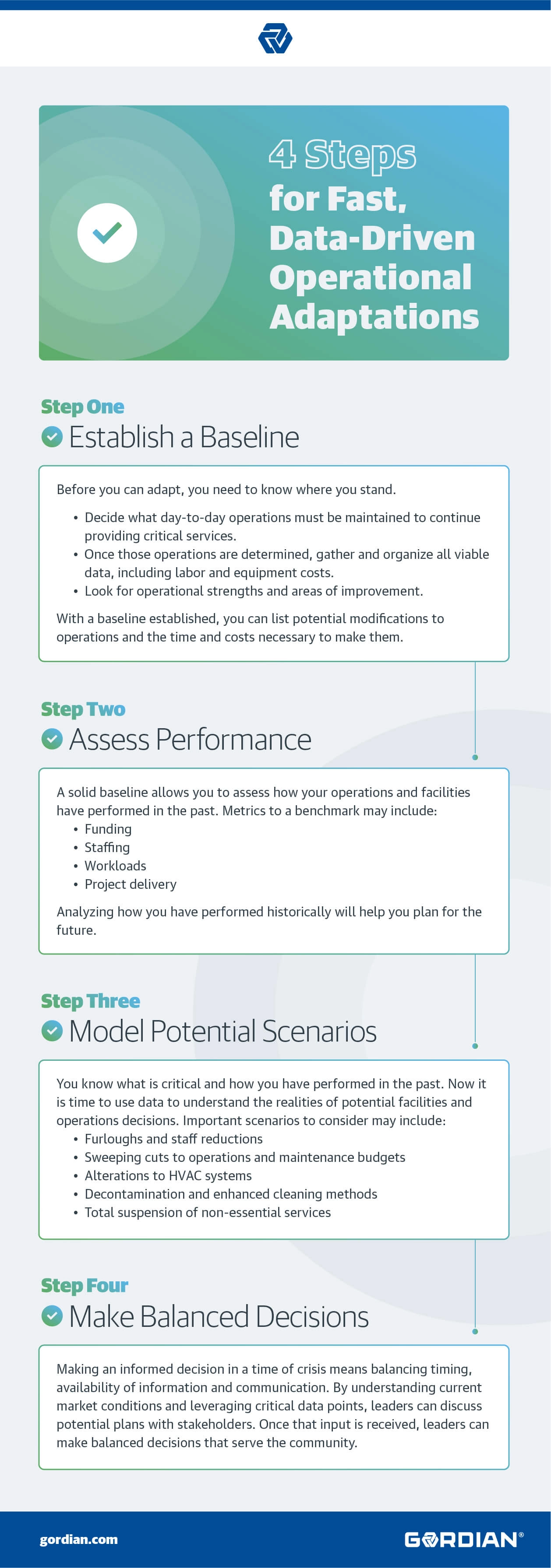How to Adjust Your Operations Quickly in Times of Crisis
If the COVID-19 crisis has taught us anything, it is that organizations need to learn to adapt to fast-changing circumstances. This is especially true for community spaces — schools, hospitals, government offices and other public facilities where large groups of people spend the bulk of their days. Part of the “new normal” is quickly planning and executing building modifications to keep people, staff and stakeholders safe while maintaining some level of service. No one is interested in another total shutdown. Every industry is learning to be agile by focusing on essential services and using data to plan for operational adaptations to future crises.
In a disaster, any action feels like progress. But a swift measure is not the same as an effective one. Staying focused on outcomes and making informed decisions about how to operate requires a command of available data. Some public entities are following a data-driven decision-making framework to adapt to these uncertain times.

Step One: Establish a Baseline for Operations and Facilities
All decision-making starts with establishing a baseline – leaders must have a clear understanding of their present circumstances before they plan future adaptations. This means determining what services are essential and gathering data regarding the people, facilities and equipment necessary for delivering those services. This data will help you uncover critical elements about your organization so you can determine your strengths and areas of improvement. You will see how your money is spent and gain clarity about information gaps that need filling before you can make informed operations decisions.
Step Two: Assess Operations Performance
Having baseline information allows you to assess how your facilities and your operations have performed historically. Review data for metrics including workloads, staffing levels, project delivery, funding and their relationship to the services you were able to provide at the time. No data point exists in a vacuum, so be sure to consider the contextual totality of the information at hand.
Using these historical data points, you can set benchmarks for your organization. These benchmarks will serve as targets for improvement when tomorrow’s challenges arise.
Step Three: Model Potential Scenarios
With a list of current services, their associated data and benchmarks of past performance, your organization can begin modeling scenarios and comparing your options. A solid baseline of data is crucial at this juncture because it helps you predict expenses and have the financial influence to execute your adaptations when the time comes.
Let’s use the COVID-19 pandemic as an example of the importance of modeling before adaptations must be made. Knowing what they know now, decision-makers leading our community spaces can reasonably predict the cost of enhanced cleaning methods and increased ventilation rates, identify how furloughs impact service levels and consider temporary operational changes. This information will help them create better, more realistic predictive models based on data and historical performance. That is a terrific starting point for making decisions.
Step Four: Balanced Decision-making
Balanced decision-making can be impacted by three factors: timing, availability of information and communication. The time to communicate any changes to or deviations from a strategy is in the planning phase when changes are the cheapest. If decisions regarding facilities and operations adaptations are not made until a crisis strikes, the effort to agree on a new course of action will be substantial and the costs to implement those actions may be great. By understanding current market conditions and leveraging critical data points in the planning process, consequences can be reduced and perhaps prevented altogether. However, a decision cannot be made without input from staff. They should be made aware of potential adaptations early and be allowed to be heard. Hearing the experiences and concerns of the people directly affected by the plans only strengthens the decision-making process.
Good Data is the Basis for Smart Operational Adaptations in Uncertain Times
Taking an agile approach with trusted data will help drive balanced decision-making before and during times of crisis. By using reliable data and internal benchmarks, you will be able to support your teams in making collaborative, informed decisions based on predictive insights. Being proactive, linking short-term operational decisions to long-term objectives will drive you towards recognizing and realizing the best possible outcomes for the people who depend on your organization.
Preparing to re-open? We’ve put together a checklist to help you assess your facilities.
Share this:





